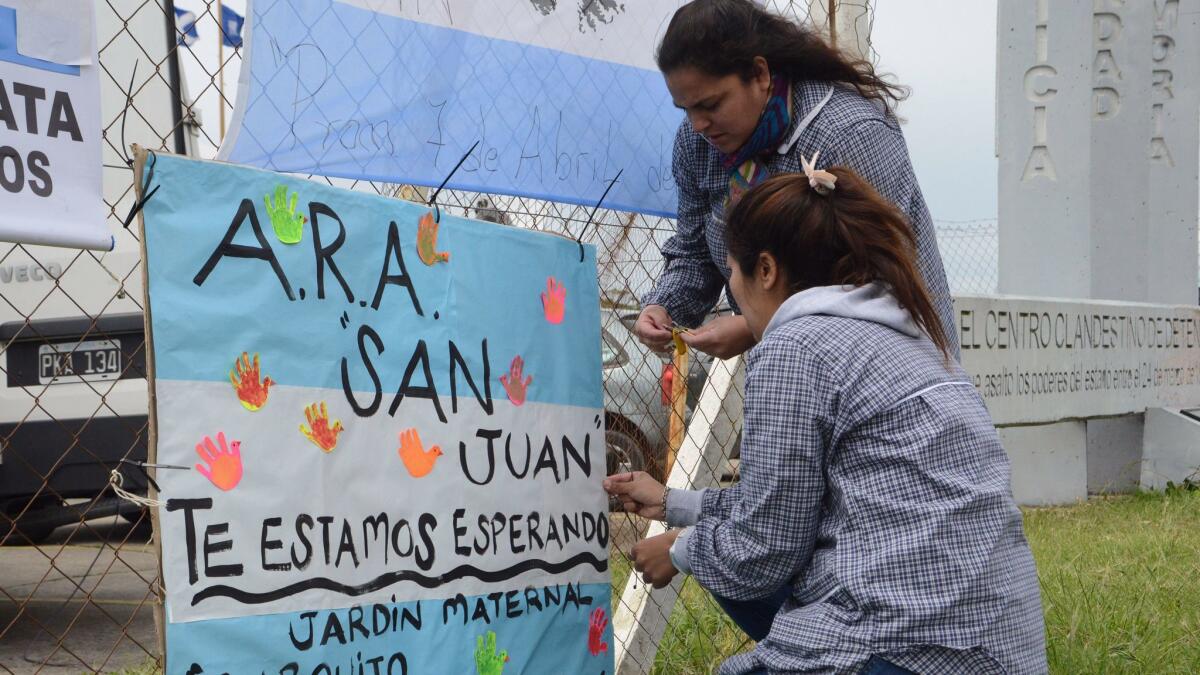Sounds heard in deep ocean were not distress signals from missing submarine, Argentine navy says

Hopes that strange sounds detected on the ocean floor might be distress signals from a missing Argentine submarine crew were dashed Monday night after an analysis indicated they were not metallic in nature.
Earlier in the day, Argentine navy spokesman Enrique Balbi said the noises picked up by sonar at a depth of 650 feet about 200 miles off the Argentine coast might be from the crew of the San Juan, a diesel-electric powered submarine missing in the southern Atlantic since Wednesday.
The sounds were detected by one of half a dozen ships participating in a multi-nation search operation racing against time to find the submarine and its 44-member crew. The navy described the sounds as resembling those made by objects striking a submarine’s metal hull.
But Balbi told reporters Monday night that the sounds were not metallic but “biological” in nature and thus not connected to the submarine, which disappeared en route from Ushuaia in Argentina’s southern Patagonia region to Mar del Plata naval base, which is about 250 miles south of Buenos Aires, the capital.
The news was the second crushing disappointment experienced by family members of the crew who have congregated at the Mar del Plata base to await word on their loved ones. Earlier Monday, the navy formally withdrew its statement Saturday that the crew had sent seven satellite messages, a revelation that raised hopes that a rescue might be in the offing.
The navy also confirmed that the submarine’s captain reported a failure in the vessel’s battery system Wednesday before losing all radio contact. Officials did not explain why they waited until Monday to disclose the captain’s distress call.
Officials said the San Juan’s captain, Pedro Martin Fernandez, messaged Wednesday that the vessel was at “the start of a breakdown” and had a short circuit in its battery system. The 30-year-old, German-built submarine operates on a combination of diesel and electric power.
Upon hearing the captain’s communication, officials ordered him to sail the ship into the Mar del Plata naval base “by the most direct route,” Argentine navy spokesman Gabriel Galeazzi said. “Breakdowns are normal, they are reported all the time … [and] can affect navigation, which is why all possibilities are being analyzed.”
Word of the submarine’s mechanical problems came as search operations intensified in storm-tossed waters off Argentina’s Patagonian coastline. Swells as high as 27 feet were reported by ships participating in the seven-nation search-and-rescue operation. The Argentine navy tweeted video showing the intense weather conditions.
With family members’ emotions seesawing with every scrap of information, fears that time may be running out for the crew lent the rescue operation a sense of urgency. If the San Juan has not surfaced since it disappeared Wednesday, it is thought to have only a seven- or eight-day supply of oxygen. Monday marked the fifth day of its disappearance.
The operation includes vessels and aircraft from the U.S., United Kingdom, Brazil, Chile, Peru and France, in addition to Argentina.
The U.S. Navy’s Southern Command said early Monday that it was dispatching four unmanned underwater search vehicles to Argentina to assist in the search. The U.S. Navy has already promised two patrol aircraft, and NASA has lent an airplane loaded with instruments that can detect anomalies above or below the ocean’s surface.
U.S. Navy diving teams specializing in deep sea rescues have also been sent to Comodoro Rivadavia, the Patagonian city where the rescue operation is headquartered.
Despite poor weather conditions, the international rescue team is “scouring the bottom of the ocean with sonic equipment” that is capable of creating three-dimensional pictures of the ocean floor in efforts to locate the sub, navy spokesman Balbi said.
Families of the 44 crew members are being kept informed of the search, and Galeazzi acknowledged that many expressed “discouragement” after the navy told them that the Saturday report of satellite communication attempts by the crew was in error.
“It affects the families because they are hoping for any new fact,” Galeazzi said.
On Monday, Argentine President Mauricio Macri visited the Mar del Plata naval base to talk with the family members gathered there.
Special correspondents D’Alessandro and Kraul reported from Buenos Aires and Bogota, Colombia, respectively.
UPDATES:
6:20 p.m.: This article was updated to report that sounds detected Monday were not distress signals from the missing submarine.
This article was originally published at 12:40 pm.
More to Read
Start your day right
Sign up for Essential California for news, features and recommendations from the L.A. Times and beyond in your inbox six days a week.
You may occasionally receive promotional content from the Los Angeles Times.






